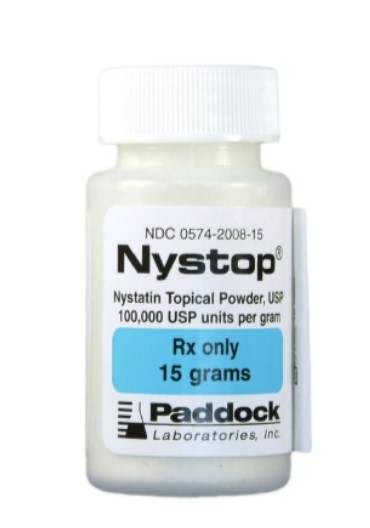
Welcome! Wound Reference is a one-stop information resource for the wound care community. Register for FREE access to: favorites lists, feature comparisons, reimbursement data, patient handouts and more.
Visit Product Navigator
Other related brands
Perrigo Company | Model: 00574200815 |
HCPCS : (Medicare DME co-payment per billable unit min / max: $0.00 / $0.00)
Nystatin is a polyene antifungal antibiotic.
INTENDED USES: Indicated in the treatment of cutaneous or mucocutaneous mycotic infections caused by Candida albicans and other susceptible Candida species.
CLAIMED BENEFITS: Nystatin is an antibiotic which is both fungistatic and fungicidal in vitro against a wide variety of yeasts and yeast-like fungi. Nystatin acts by binding to sterols in the cell membrane of susceptible species resulting in a change in membrane permeability and the subsequent leakage of intracellular components.
Wound Reference does not produce, market, re-sell or distribute health care goods or services consumed by, or used on, patients.
|
Cream |
|
Ointment |
|
Powder |
|
Spray |
It is estimated that 10% to 20% of the world population is affected by fungal skin infections.[1] Antifungal skin care products come as ointment, solutions, lotions, powder, gel, spray or lacquer that help prevent and treat most topical skin irritation due to superficial fungal infections. These products help relieve itching, burning and irritation due to fungal infections including tinea cruris (jock itch), tinea corporis (ringworm), (athlete's foot) and Candida albicans (yeast). May contain antifungal drugs such as miconazole. May contain other substances such as zinc oxide to protect skin from exposure to urine and feces, vitamins, oils and skin conditioners.
[1] El-Gohary M, et. al. Topical antifungal treatments for tinea cruris and tinea corporis. Cochrane Database Syst Rev. 2014 Aug 4;(8)
You can purchase this product directly at pharmacies and medical supply stores. Please refer to table "Other Stores" below for pricing and suggestions on where to purchase this product "out-of-pocket" (without insurance). If there are no vendors listed and you would like to have information on suppliers, please email info@woundreference.com�.


Other related brands:
InterDry®, 10 x 36'', 10/box,
InterDry®, 10 x 144'', 1/box,
Remedy with Phytoplex Antifungal Ointment, 2.5 oz., eac...,
Remedy Phytoplex Antifungal Powder, 3 oz., each,
InterDry®, 10 x 18", 40/box,
Critic-Aid® Clear AF, 5 oz./142 g, 12/box,
* Wound Reference does not produce, market, re-sell or distribute health care goods or services consumed by, or used on, patients.
** We do not accept paid advertising to guarantee unbiased product information
Important Notice: The product information contained on this page, including the product images and additional product materials, was collected from various supplier sources. All product claims and specifications are those of the product suppliers. Every effort has been made to ensure the accuracy of the product information, however on occasion manufacturers may alter their products or packaging without notice. Wound Reference assumes no liability for inaccuracies or misstatements about products. The properties of a product may change or be inaccurate following the posting or printing of the product information in the document, either in the print or online version. Due to product changes, information listed in this document is subject to change without notice. We recommend that you always read labels, warnings and instructions for use before using a product. Content on this site is for reference purposes and is not intended to be a substitute for professional advice given by a physician or other licensed healthcare professional.